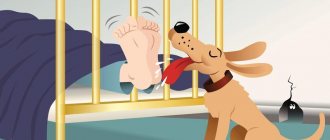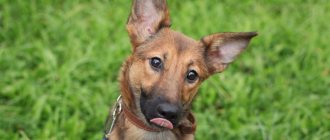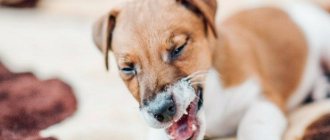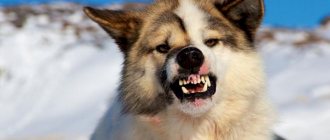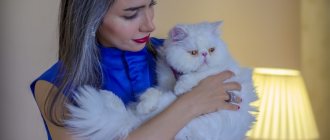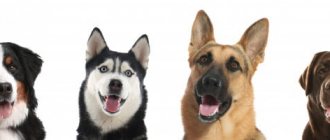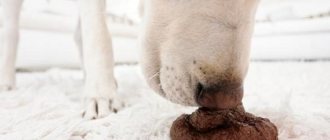The habit of a four-legged friend to lick his owner does not always indicate love for him. Dog breeders tend to attribute human qualities and emotions to their pets, therefore they explain their actions and habits without taking into account the physiology, instincts, and psyche of their four-legged friend.
Such “humanization” does not always benefit the dog, so veterinarians strongly advise, before getting one, to study the peculiarities of behavior and keeping of animals. Otherwise, problems with understanding cannot be avoided.
A dog licks its owner: reasons
Showing love in dogs
The mother constantly licks the puppies before and after feeding - this is both a necessary hygiene measure, a massage to improve digestion, and a way to calm the little blind creature and let him know that he is not alone. Having matured, the puppy begins to lick its mother in response, demanding affection or showing that it is hungry. And when a person replaces the mother, he automatically begins to show his needs to him in this way. An adult dog, expressing devotion and joy, can run its tongue over the face and hands of the owner, unable to otherwise show feelings.
The dog constantly licks the puppies - this is both a necessary hygiene measure and a massage to improve digestion
Asking for help, stress
“Dog kisses” are not always an expression of positive emotions; in some cases, it is a clear signal that the dog needs your help or is experiencing negative emotions.
A dog frantically licks a person with its tongue when:
- needs his attention;
- scared;
- punished;
- offended, excited;
- feels unwell, etc.
Licking may be accompanied by a plaintive whine, the dog tucks its tail, moves around, crawls, tries to climb into the owner’s bed, behaves restlessly and noisily. Try to calm the animal down, let it know that you are nearby and will not hurt it.
Why do dogs lick their feet and what does it mean?
There are several reasons why a dog often licks a person's feet.
- Salt : the diet does not have enough sodium and chlorine, which are necessary for the normal functioning of the stomach; without them, the body does not produce hydrochloric acid, which means that the process of digesting food is disrupted and appetite worsens. By licking sweat from its feet, the dog tries to get the substances it needs.
- Smell : in the wild, strong odors give away the animal; instinct forces the dog to take care of the cleanliness of the owner’s feet so that the specific aroma does not give them away to the enemy.
- Fear : a humiliated, timid touch of the tongue may indicate disturbances in the relationship between man and animal, frequent aggression directed at the dog; serious correction of human behavior is required.
- Wounds : Infected scratches or wounds on the legs prompt the four-legged "healer" to use the most powerful healing agent at his disposal - his own saliva.
Legs are the most accessible part for showing special feelings to the owner
On a note! Surprisingly, even if there is no visible damage, the dog may begin to show increased interest in that part of the body where the inflammation is just beginning, as if it senses an approaching attack of arthritis or gout, trying to “remove” the pain.
The meaning of things
Different animals see objects around them differently. A dog who looks around the room does not at all consider himself surrounded by a person’s things - all these are objects of his world. Our ideas about what this or that object is intended for may or may not coincide with a dog’s. The meaning of things is determined by what we do with them (von Uexküll called this “functional tone”). A dog may be indifferent to chairs, but if you teach him to jump on them, the chair becomes something to sit on. Subsequently, the dog may independently discover that there are other things intended for sitting: a couch, a pile of pillows, or, for example, a person’s lap.
So, we begin to understand in what ways the ideas about the world of dogs and humans are similar and in what ways they are different. For dogs, many objects in the surrounding world are associated with food - much more than for people. Moreover, they distinguish “functional tones” that do not exist for us - for example, things that can be tastefully rolled on. If we are not children and are not inclined to such games, then the number of such objects tends to zero for us. And on the contrary, a huge number of things that have a strictly defined meaning for us (forks, knives, hammers, pushpins, fans, watches, etc.) have no (or almost no) meaning for dogs.
So, there is no hammer for a dog. It means nothing to her, at least until it is associated with another, meaningful object (for example, the owner uses it; the cute dog who lives down the street urinated on it; it has a wooden handle that can be chewed on).
When the umwelts of a dog and a person collide, then, as a rule, people do not understand what their pets are doing. For example, a person quite seriously states that his dog knows that he has nothing to do on the bed. A person can even buy a special dog bed and order the dog to go lie down there. Usually the dog obeys. The person feels satisfied. Still, another step towards mutual understanding has been taken.
But is it? Many times, returning home, I found a crumpled, still warm bed and realized that either my dog had just been lying there, joyfully greeting me on the threshold, or some unknown invisible alien. We easily formulate: a bed is intended for a person, a dog bed is for a dog. A human bed is a place to rest and may contain expensive linens and a variety of pillows. It wouldn’t even occur to us to sit on a dog bed that cost us (comparatively) little and is strewn with chewed up toys.
What about the dog? She doesn't see much difference between her bed and ours, but ours is much more attractive. After all, a bed smells like a person, and a dog bed smells like something that the master happened to have at hand. The bed is where we spend some time; Sometimes there are crumbs scattered and clothes lying around. Of course, the dog will prefer our bed to his bed! She doesn't know why we perceive this place differently. Of course, a dog can remember that a human bed is something special if he is regularly scolded for lying on it. But then he will understand not the difference between his bed and our bed, but rather the difference between the places where he can and cannot lie unhindered.
In the dog world, a bed does not have a “functional tone.” Dogs sleep where they can, and not where we would like them to. For relaxation, they choose places where they can lie down comfortably, where it is not hot or cold, there are relatives and it is safe. Almost any flat surface in the house meets these requirements. Design a corner to suit your dog's tastes, and your pet will likely find it just as desirable as a bed.
Reasons why a dog licks its owner
Only interest, love and devotion can make a dog lick a person. And she does this, most often showing concern. By blackmailing with their touching behavior, dogs accustomed to this can extort sweets, which are constantly pampered, rewarded with harmful goodies.
Dog owners should be aware that animals have a keener sense of smell than humans; even an almost indistinguishable aroma can irritate the pet, causing it to “wash” the person - for the benefit of the unreasonable creature, of course, in order to disguise it, hide it from enemies, and make it less noticeable.
A dog may lick its owner simply to show that it is nearby, to indicate its presence and support. Sensing a person’s mood, four-legged friends sense when the owner is feeling bad and console them as best they can.
If a dog licks you, it is showing concern.
What might a dog want to “say” when licking a person?
A dog can lick even an unfamiliar but pleasant person by touching his hand or tongue. This is more typical for kids, but adult dogs sometimes indulge in this to show friendliness. Scientists believe that this is how the dog “remembers” a new creature, as if introducing its taste and smell into a kind of database. Active, sociable and well-socialized representatives of some breeds invite you into their company and offer to play. Children, who receive affection more often than others, enjoy special sympathy.
The dog licks your face and hands
Most often, this is how the pet shows that it is hungry.
He often receives tasty rewards from his hands, and his face always smells like food to them. If the dog is not bored and tries to greet the person, then it is worth checking its bowls of food and water.
“Foreign” odors could remain on the hands and face, which the dog is trying to eliminate
They love the taste of your skin
A dog may lick its owner simply because it likes the taste of his skin. Human sweat has a salty taste, which is very pleasant for animals. They associate it with food.
Put Ethics First: What to Do When You Have a Very Flirty Coworker
For a stable relationship and other reasons not to show your wealth to a guy
Attractiveness, demand: laser shooting range as a business - is it worth opening a business
Your dog may also like the taste of your cosmetic products. But this can be a problem, because creams contain a lot of chemicals that can harm the animal.
What to do if your dog tries to lick his owner too often
The habit of licking can cause irritation. You should not scold a puppy who has just begun to explore the world if he uses his tongue every now and then, so as not to cause him to feel insecure, lost, or resentful. As he grows up, you need to let him know that this is unpleasant, make a sharp sound (clap your palms, command “Ugh!”). Soon the dog will forget about the unpleasant habit.
It is worth contacting a veterinarian if the habit appears suddenly or cannot be weaned from it. Specialists will be able to understand the animal’s behavior problems, determine whether a lack of attention or something else is bothering the pet, and suggest correction methods.
Video - Why dogs lick their owner
Face licking
Interestingly, licking can be interpreted differently, depending on which part of the body the dog has chosen. So, if your pet is aiming at your face, it is possible that he is hungry. The fact is that when puppies stop feeding on their mother's milk, they begin to take food from her mouth. And when they are hungry, they lick her face.
Losing potential employees: why you shouldn’t scold interns at work
Millions for bonuses: Apple paid employees bonuses of up to $180 thousand
The stand-up comedian earned 1.2 million rubles from the sale of a canceled residence permit
On the other hand, dogs love to copy the behavior patterns of humans. Licking the face can be an imitation of a kiss, that is, an expression of love.
The dog senses your mood
For centuries they have been accompanying humans everywhere, dogs have learned to sense a person’s mood and his attitude towards them. They are very loyal to some, most patiently tolerate children's pranks, but there are people who cause pathological aggression in dogs.
Fear has a special smell, this has already been proven. If a person is afraid or hostile, the dog detects this instantly. And he won’t be slow to respond.
Defenselessness and friendliness make these animals want to patronize, protect and protect. By covering his face with his hands and pretending to be crying, a person can easily force his pet to show remarkable care: he will make every effort to spread his fingers with his tongue and get to the eyes and cheeks, worrying, whining, trying to call other family members for help. Only a cheerful laugh or affection from the owner can calm him down.
Licking hands
Licking hands can have an exploratory function. Depending on what a person just did, his palms may smell like food, earth, cosmetics, or detergents. If the skin smells of something tasty, it is possible that the dog licks his hands to taste them.
Dogs also associate human hands with affection. Perhaps, by licking, the animal asks you to stroke it or scratch it behind the ear. It can also serve as a show of gratitude.
How a dog sees the world - and what do dog kisses mean
Dogs see the world completely differently than we do.
Any dog lover should accept the fact that dogs are not small, peculiar people, they are creatures that see the world completely differently than we do. This applies to both physiology and lifestyle features.
| Human | Dog |
| Cognizes the world through the organs of sight, hearing, and only then smell and touch | First smells, then hears, touches (tastes, licks), and lastly looks |
| Having smelled the smell, he will turn around and find the source with his eyes to make sure that he is not mistaken. | Doesn't trust her eyes, she rushes to sniff the object to avoid mistakes |
| Capable of obtaining a large amount of information even from a picture | A dog is not interested in an immovable and odorless object. |
How to get a dog to stop licking
Licking is another way to make sure that there is a person in front of the dog: not only the smell, but the taste of the secretions of the sweat and sebaceous glands is unique for each person. By licking the owner or family member, the dog “identifies” him.
In someone else's skin
To be able to recognize the essential elements of an animal's umwelt is, in essence, to become an expert on ticks, dogs, people, and so on. This is how we can close the gap between what we think we know about dogs and what they really are.
We can try to assimilate the umwelt of another animal, to incarnate into the animal (bearing in mind the limitations imposed by our sensory system). It's an amazing thing to spend a day being as tall as a dog. Sniffing (even with our less-than-perfect noses) the objects we encounter throughout the day fundamentally changes the way we think about familiar things.
Now pay attention to the sounds in the room where you are - sounds that you are used to and that you do not usually listen to. So, with some effort, I hear the noise of a fan in the corner, the hum of a truck in the distance, the inaudible voices of people climbing the stairs; a wooden chair creaks under someone; my heart is beating; I swallow; The page rustles as it turns. If my hearing had been sharper, I might have heard the scratching of a pen on paper at the opposite end of the room, the sound of a flower growing and the insects talking under my feet. Perhaps other animals hear these sounds clearly.
Licking as an expression of love and care is inherent in dogs by nature.
The mother takes care of the puppies from the first moments of birth, carefully licking them. She remembers them, so she doesn’t always accept other people’s “children”, she makes the smell of defenseless babies elusive - this is inherent in nature to save the offspring. With her tongue, the mother massages the puppy’s muscles and belly, teaches him to move, and comforts him. Puppies, growing up, quickly learn to act the same way; they identify members of their pack using their tongue, lick each other, showing trust.
By licking puppies, the dog remembers them
Life with humans did not destroy the basic instincts of animals; it taught them to treat bipeds as members of a pack. Therefore, when accepting dog affection, owners should analyze the reasons for their occurrence in order to recognize problems in the behavior or health of their four-legged friend in time, take timely measures on their own or contact a specialist to solve the problems.
